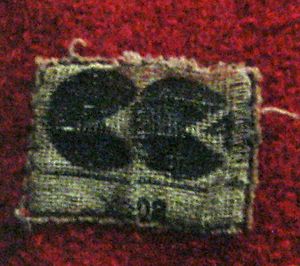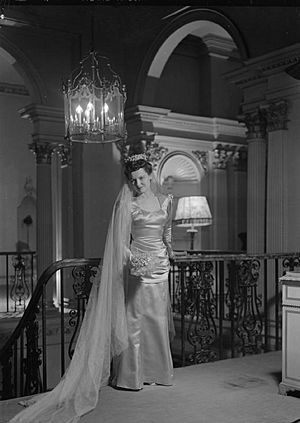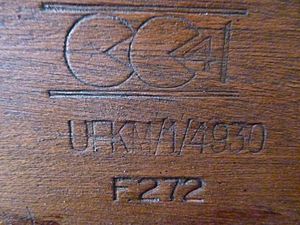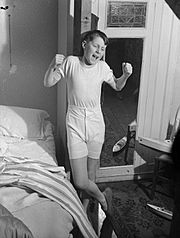CC41 facts for kids
The CC41 Utility logo was a special mark. It showed that products were made and sold as part of the British Government's Second World War Utility Clothing Scheme.
The CC41 mark meant an item met the government's rules. It could then be sold as a Utility Scheme product. This symbol was easy to spot. It helped makers, shops, and everyday people.
So, the Board of Trade said the CC41 mark had to be on all Utility products. This included clothes, shoes, furniture, and fabrics. This rule started when the scheme began in 1941. It lasted until the scheme ended in 1952.
The CC41 mark could be a label sewn on. It could also be printed right onto cloth. Or it could be pressed into items, like furniture and early Utility shoes.
People sometimes called the symbol ‘cheeses’. It was designed by Reginald Shipp. It is thought to stand for ‘Civilian Clothing 1941’.
Why the CC41 Mark Was Needed
By 1941, Britain was deep into the Second World War. The country needed to make many things for its growing army. This meant many everyday items became rationed. Some raw materials could no longer be brought into the country. Those that could were used for the war effort.
Food rationing had already started in January 1940. Items not rationed became very expensive. Clothes, for example, cost much more than before.
The government then made rules called "Limitation of Supply Orders." These rules forced factories to make much less than they did before the war. By April 1940, cuts to cloth were a big problem. Wool and rayon were cut by 25%. Linen was cut by 75%. Because of this, factories stopped making items that didn't earn much money. People started asking for clothes rationing.
At first, Prime Minister Winston Churchill thought people would not accept clothes rationing. But in June 1941, Oliver Lyttleton, who led the Board of Trade, managed to bring it in. Churchill was happy people accepted it. A month later, he replaced Lyttleton with Hugh Dalton. Churchill knew that rationing and conscription (people joining the army) were needed. Britain was now in a "total war" around the world.
Soon after Dalton took over, he appointed Metford Watkins. Watkins was in charge of civilian clothing. He knew clothes were expensive. He promised to make cheaper clothes. These would be "austerity" clothes, meaning simple and basic. Soon after, the government announced "national footwear." These austerity rules said exactly what could or could not be used. For example, they limited buttons, pleats, or pockets. They also set rules for heel height, lace, or embroidery. Trousers could not have turn-ups, and suits could not be double-breasted.
In October 1941, a "purchase tax" was added. This tax made some items more expensive. But necessary items were tax-free. This helped factories make more essential goods. It also reduced waste. And it made expensive clothing less common.
Utility Products
Special "Utility cloths" were introduced. Factories received materials based on how much they promised to make. Factories that made more Utility cloth got more materials. People bought Utility clothing because it was tax-free.
By September 1942, 40 types of cloth were approved. These included wool, cotton, rayon, and locknit. All these cloths now used the CC41 Utility mark. Reginald Shipp designed this mark.
The symbol had to appear on clothing, shoes, and furniture. This single, easy-to-spot mark quickly told people if an item was tax-free. The symbol became known for cheap, but good quality goods. Utility footwear sometimes had different quality levels. For example, ladies' shoes might have the Utility mark and W1, W2, or W3. These numbers showed different price ranges, with W3 being the most expensive.
See also
- Incorporated Society of London Fashion Designers (IncSoc)
- Utility Clothing Scheme
- Utility Furniture
- Rationing in the United Kingdom
- Make-Do and Mend






